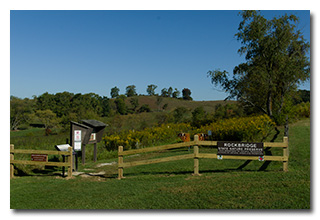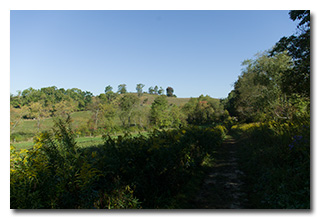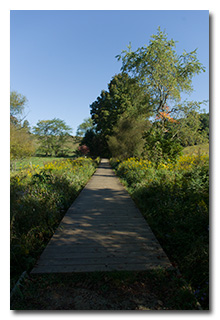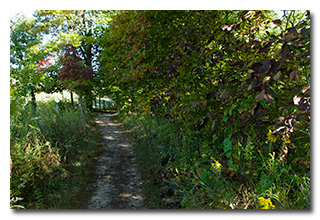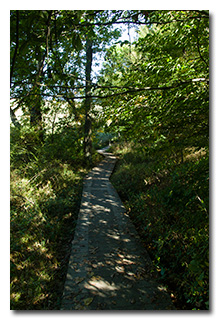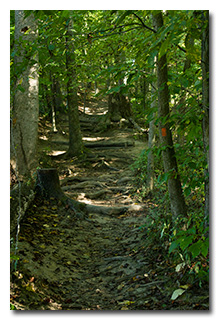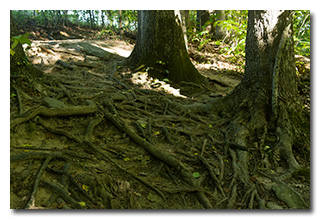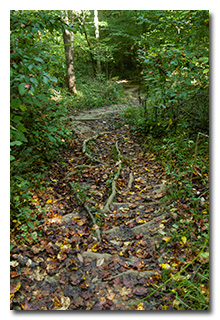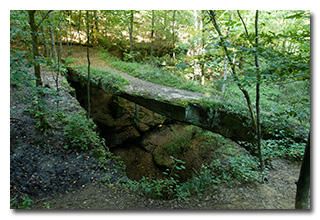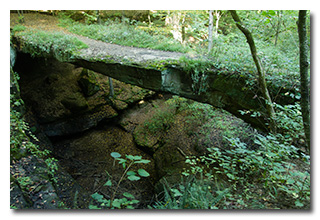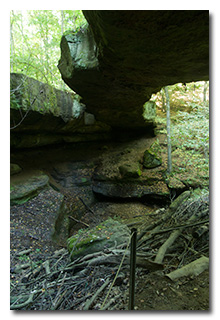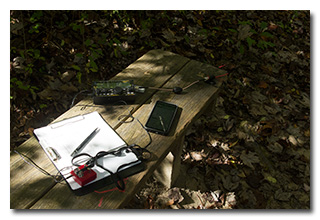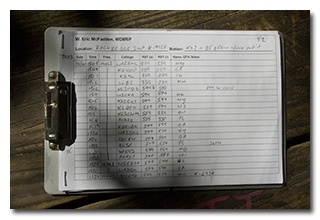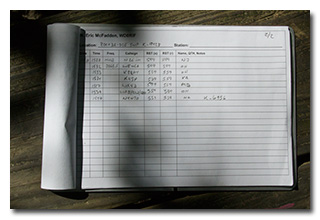
by William Eric McFadden
From the nature preserve's website:
-
Rockbridge's natural arch or bridge is more than 100 feet long and 10 to 20 feet wide, and gracefully arches 50 feet across a ravine. It is considered the largest natural bridge in Ohio.
Rockbridge Natural Bridge originated millions of years ago, when Ohio lay under a warm inland sea. Rivers flowed into the vast body of water, carrying both fine and coarse grained sands which settled to the sea bottom. Over the centuries, the accumulating sand thickened, compressed and formed the hard sedimentary rock known as Black Hand sandstone. Eventually, great pressure from beneath the earth's surface caused the land in eastern North America to rise, forming the Appalachian Mountains. The inland sea soon drained away, exposing the newly uncovered rock layers to steady erosional processes. The natural bridge soon began emerging in all its grandeur. Wind, rain and percolating groundwater worked together for centuries, carving a deep cave-like recess in the softer midportion of the Mississippian Black Hand sandstone. Gradually, erosional forces also worked along a natural joint plane some distance behind the brink of the cliff. Over the centuries, this ongoing process has widened the crevice, and all that remains of the overhanging ledge is the narrow rock arch.
Pictures
Description
On Sunday, October 1, 2023, one member of the Southeast Ohio Radio Adventure Team performed a successful pedestrian-portable activation of Rockbridge State Nature Preserve in Ohio as part of the Parks on the Air (POTA; link) program.
While on the way home from dropping his son Miles off at John Glenn Columbus International Airport, Eric McFadden, WD8RIF, stopped at the nature preserve for an activation. Because he had some time, and because he had previously performed activations of this unit five times without once exploring beyond the trailhead parking lot, Eric decided to hike the trail to finally see the famous natural rock bridge and to perform his sixth activation of the unit pedestrian-portable, somewhere along the trail.
Eric parked at the trailhead parking area, loaded up with his gear, and began his hike into the state nature preserve at 1409 UTC. Eric carried his KX2 Mini Travel Kit over his left shoulder; his DLSR on his neck; and a backpack containing his water bottle, logsheets, a towel1, his Goture Red Fox Super Hard 720 carbon-fiber mast, and mast-mounting spike on his back.
The hike was less smooth than Eric had anticipated, and hillier, but Eric had no trouble negotiating any part of the trail. As he hiked, he kept an eye out for possible operating locations and identified two trailside benches that might work.
In due course, Eric arrived at the natural rock bridge and found it to be spectacular.
After soaking in the grandeur of the natural rock bridge for a few minutes, Eric began to retrace his steps back along the trail. Upon arriving at the better of the two benches he had identified as possible operating locations, he set up his station. Eric placed his mast mounting spike into the soft soil a few feet from the edge of the trail and about twenty feet from the bench. He deployed his Tufteln (link) 35' EFRW antenna as a sloper from the bench to the top of the mast, with one 17' counterpoise wire arranged underneath the 35' radiator. Placing his Elecraft KX2 on the bench, Eric was on the air at 1503 UTC.
Eric was very pleased to find he had good cell-signal this deep into the nature preserve and would be able to spot himself on POTA Spots (link) and to use POTA Spots to identify possible park-to-park (P2P) QSO opportunities.
Eric began his operation on 20m by finding a clear frequency to run, spotting himself to POTA Spots, and calling "CQ POTA". He was pleased to be quickly auto-spotted on POTA Spots. His first QSO came at 1505 UTC with WA5RML in New York. Initially, QSOs came slowly, but after the third QSO, Eric's QSO rate increased dramatically, with Eric's twentieth QSO coming at 1528 UTC with N2EIM in New Jersey. This run included a P2P QSO with VE3CWM at Diefenbunker National Historic Site (VE-5083), a P2P QSO with N4NTO at Tar River State Game Land (K-6956) in North Carolina and QSOs with operators located in New York (3), Georgia (3), Illinois, Minnesota, Ontario (2), North Carolina (3), New Jersey (2), Florida (2), Maryland, Wisconsin, and Pennsylvania.
Switching to 40m, Eric found a clear frequency to run, began calling "CQ POTA", and was again quickly auto-spotted on POTA Spots. Eric's first QSO on this band came at 1532 UTC with W8NGA in Ohio. QSOs came steadily, with Eric's sixth QSO in this run coming at 1540 UTC with N4NTO who was still at Tar River State Game Land (K-6956) in North Carolina. This run included the aforementioned P2P QSO and QSOs with operators located in Ohio (3), Virginia, Maryland, and North Carolina.
In all, Eric made twenty-six QSOs, including three P2P QSOs, in thirty-seven minutes of on-air time. All of Eric's QSOs were CW and were made with five watts output.
Eric's hike was three miles in length and included 314' of climb.
Footnotes:
[1] "A towel, (the Hitchhikers Guide to the Galaxy) says, is about the most
massively useful thing an interstellar hitchhiker can have. Partly it has great practical value — you
can wrap it around you for warmth as you bound across the cold moons of Jaglan Beta; you can lie on it on
the brilliant marble-sanded beaches of Santraginus V, inhaling the heady sea vapours; you can sleep under
it beneath the stars which shine so redly on the desert world of Kakrafoon; use it to sail a mini raft down
the slow heavy river Moth; wet it for use in hand-to- hand-combat; wrap it round your head to ward off
noxious fumes or to avoid the gaze of the Ravenous Bugblatter Beast of Traal (a mindboggingly stupid animal,
it assumes that if you can't see it, it can't see you — daft as a bush, but very ravenous); you can wave
your towel in emergencies as a distress signal, and of course dry yourself off with it if it still seems to
be clean enough. More importantly, a towel has immense psychological value. For some reason, if a strag
(strag: non-hitch hiker) discovers that a hitch hiker has his towel with him, he will automatically assume
that he is also in possession of a toothbrush, face flannel, soap, tin of biscuits, flask, compass, map,
ball of string, gnat spray, wet weather gear, space suit etc., etc. Furthermore, the strag will then
happily lend the hitch hiker any of these or a dozen other items that the hitch hiker might accidentally
have 'lost'. What the strag will think is that any man who can hitch the length and breadth of the galaxy,
rough it, slum it, struggle against terrible odds, win through, and still knows where his towel is is
clearly a man to be reckoned with." — Douglas Adams, The Hitchhiker's Guide to the Galaxy
(return)
